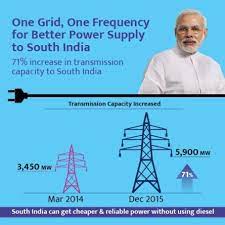03 Jan 2022 One Nation One Grid One Frequency

One Nation One Grid One Frequency- Today Current Affairs
- Recently Power Grid Corporation of India Limited (PGCIL) celebrated the anniversary of operation of ‘One Nation-One Grid-One Frequency’ i.e. National Grid.
Development of National Grid: The Hindu Analysis
- National grid management on a regional basis started in the 60
- The Indian power system is divided into five regional grids for planning and operational purposes.
- In the early nineties, the concept of integration of the regional grid and thus the establishment of a national grid was conceived.
- Initially the state grids were interconnected to form a regional grid and India was demarcated into 5 regions namely North, Eastern, Western, North Eastern and Southern.
- In the year 1991, the North-Eastern and Eastern grids were connected. Apart from this, in the year 2003, the Western Region Grid was connected to it.
- In August 2006 the North and East grids were interconnected, making 4 regional grids connected synchronously and operating on the same frequency as a central grid.
- Southern Region was connected to the Central Grid on 31st December To achieve ‘One Nation, One Grid, One Frequency’.
- All possible measures are taken to ensure that the grid frequency always remains within the 90-50.05 Hz band.
Significance of a Frequency: The Hindu Analysis
- Maintaining a consistent power frequency is important because many frequencies cannot operate alongside each other without damaging the equipment.
- This has serious implications while providing electricity at the national level.
National Grid Capacity:
- The country currently has a total inter-regional transmission capacity of about 1, 12,250MW, which is expected to increase to about 1, 18,740MW by the year
Advantages of One Nation One Grid One Frequency: Today Current Affairs
- Demand-supply matching: Coordination of all regional grids will help in optimum utilization of scarce natural resources by transfer of electricity from resource-intensive areas to load-intensive areas.
- Development of electricity market: In addition, it will pave the way for the establishment of a vibrant electricity market, which will facilitate trade in electricity in all regions.


No Comments